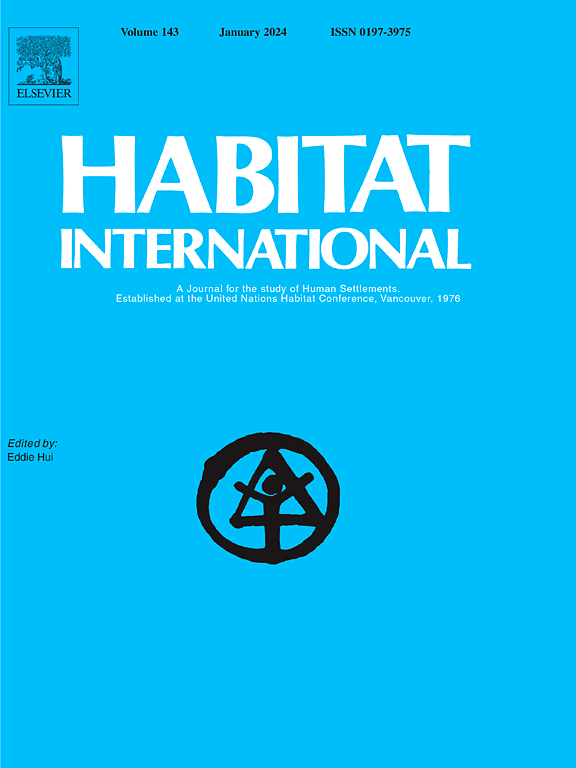Between proximity and security: A log-linear choice modeling of displacement risks and residential mobility trade-offs in immigrant Sub-Saharan communities
IF 6.5
1区 经济学
Q1 DEVELOPMENT STUDIES
引用次数: 0
Abstract
The elusive nature of displacement risks experienced by marginalized communities in rapidly developing economies presents a deepening equity dilemma that has received insufficient scholarly attention. Despite the widespread disruptions to livelihoods and safety in these fast-growing communities, the disproportionate impacts on neighborhood-level relocations – an often-occurring housing tenure dissonance – remains not well understood. Our study attempts to bridge this gap by examining the built environment determinants of residential mobility and the associated displacement risks in historically marginalized immigrant communities in Sub-Saharan Africa, using the Kumasi Metropolitan Area in Ghana as a case study. A mixed-method approach is employed, combining both log-linear regression and exploratory factor analysis techniques to conceptualize place utility attachments while choice-modeling displacement likelihood. Results revealed a dual conundrum in household relocation decisions, diffused between the competing trade-offs of livability and livelihood. While proximity to employment networks in inner suburbs remains the key determinant of housing choice, the insecurity of land tenure in these transitional areas creates an ever-present risk of displacement. Conversely, relocation to more tenure-secure areas often comes at the cost of reduced access to work opportunities, loss of economic stability, and diminished social capital tied to their current location. Also, neighborhood safety and crime-related stress associated with housing had the highest predictive effect on actual relocation decisions and or the likelihood of moving from these communities. The study discusses the implications of these intricate relationships on urban development, gentrification, and inclusive housing, offering empirical insights to guide policy directions for equitable, safer, and sustainable living environments in marginalized communities.
邻近与安全之间:撒哈拉以南移民社区流离失所风险和居住流动性权衡的对数线性选择模型
在快速发展的经济体中,边缘化社区所经历的流离失所风险难以捉摸,这带来了一个日益加深的公平困境,而这一困境并未得到足够的学术关注。尽管这些快速发展的社区的生计和安全受到广泛破坏,但对社区一级重新安置的不成比例的影响-一种经常发生的住房使用权不协调-仍然没有得到很好的理解。我们的研究以加纳库马西大都会区为例,研究了撒哈拉以南非洲历史上边缘化移民社区中住宅流动性和相关流离失所风险的建筑环境决定因素,试图弥合这一差距。采用混合方法,结合对数线性回归和探索性因子分析技术,概念化地点效用依恋,同时选择建模位移可能性。结果显示,在宜居性和生计之间的竞争权衡中,家庭搬迁决策存在双重难题。虽然靠近内郊区的就业网络仍然是住房选择的关键决定因素,但这些过渡地区土地使用权的不安全造成了永远存在的流离失所风险。相反,搬迁到更安全的地区往往以减少获得工作机会、失去经济稳定性和减少与当前地点相关的社会资本为代价。此外,与住房相关的社区安全和犯罪相关压力对实际搬迁决策和/或从这些社区搬迁的可能性具有最高的预测作用。本研究探讨了这些错综复杂的关系对城市发展、中产阶级化和包容性住房的影响,为指导边缘化社区公平、安全和可持续的生活环境的政策方向提供了经验见解。
本文章由计算机程序翻译,如有差异,请以英文原文为准。
求助全文
约1分钟内获得全文
求助全文
来源期刊

Habitat International
Multiple-
CiteScore
10.50
自引率
10.30%
发文量
151
审稿时长
38 days
期刊介绍:
Habitat International is dedicated to the study of urban and rural human settlements: their planning, design, production and management. Its main focus is on urbanisation in its broadest sense in the developing world. However, increasingly the interrelationships and linkages between cities and towns in the developing and developed worlds are becoming apparent and solutions to the problems that result are urgently required. The economic, social, technological and political systems of the world are intertwined and changes in one region almost always affect other regions.
 求助内容:
求助内容: 应助结果提醒方式:
应助结果提醒方式:


